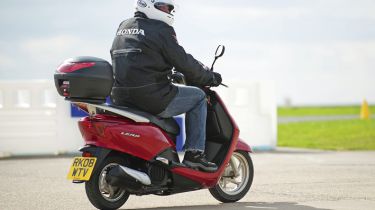On Your Bike!
Want to cut your commute? Here’s all you need to know on switching to two wheels.

The motorcycle test was toughened up at the end of April, but drivers looking to switch to two wheels to cut their journey time to work and save cash should not be put off.
Commuter machines are typically under 125cc and unaffected by the changes to the test. The revisions bring the UK in line with the rest of Europe, and add some off-the- highway manoeuvres into what is now a two-part motorcycle practical assessment.
The fresh sections include emergency avoidance at 32mph, plus some parts previously done on the road, like the U-turn and emergency stop. And this new test only affects those who want to carry pillion passengers or ride machines bigger than 125cc.
So, what do you have to do to swap crowded roads and public transport for easy commuting, free parking and no congestion charge? For urban commuters, a 125cc machine – often a twist-and-go automatic scooter – is more than up to the job of tackling a 20 mile-plus journey.
Many will top 60mph for short dual carriageway runs, and have under-seat or top box storage for helmets and bags. Expect to pay around £2,500 new.
To ride a machine up to 125cc, you need to do compulsory Basic Training (CBT). These courses cost about £100, and are valid for two years, although you still have to fit L-plates after passing.
Used - available now

2016 BMW
5 Series
107,200 milesAutomaticDiesel2.0L
Cash £9,000
2023 Audi
e-tron
48,154 milesAutomaticElectric
Cash £18,000
2015 Volkswagen
Golf GTD
84,621 milesAutomaticDiesel2.0L
Cash £12,000
2016 Tesla
Model S
78,000 milesAutomaticElectric
Cash £18,999At the end of the two years, you can either redo the CBT or switch to something bigger – where the revised test comes in. It includes a theory section, plus the new two-part exam, and if you include training, the total could reach £700. An alternative is a moped, for £500 or so less than a scooter.
This is restricted to 50cc and 31mph, and if you passed your driving test before 1 February 2001, you can ride it without doing a CBT or fitting L-plates.
You can spend a fortune on a helmet and protective clothing, but we’d budget for at least £400. So now you’re ready to ride, what is it like? Assistant consumer editor and motorbike virgin Graeme Lambert went to BSM Rider Training to find out.
Verdict
Having driven cars for more than 10 years, I was daunted by the prospect of riding a scooter for the first time. Yet I was pleasantly surprised.
BSM Rider Training kitted me out with a protective jacket and helmet, plus a 100cc Honda Lead scooter. I stayed on a private test area, and while I was wobbly at first, within minutes I felt as if I’d be ready for the road. In fact, it was great fun!
As the name suggests, twist-and-go scooters like this couldn’t be easier to ride. And although I got my taster in a safe environment a world away from busy city streets, the idea of cutting my commute and motoring bills this way really appeals.
- Graeme Lambert
Assistant Consumer Editor







